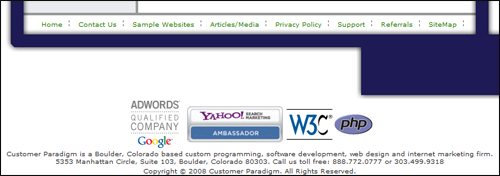eLearning Series
Your Footer Navigation’s Five Critical Elements
Research shows that more advanced users often rely on the footer navigation to find their way around. The advanced user typically doesn’t patiently sift through your site – they want to find what they are looking for as quickly as possible. Some web developers view a footer navigation as repetitive. They might claim that it takes away from the design esthetic of the site. While that might be true in some cases, not including a footer navigation can be a big mistake. Here are the five critical elements to include in a footer navigation:
1. Links to the home page and other top-level pages. These should be the links to the most important sections of your site. On the Customer Paradigm site, we link to: Home Contact Us Sample Websites Articles/Media Privacy Policy Support Referrals SiteMap.
2. Links to your sitemap and privacy policy. You often don’t want to waste valuable navigation space toward the top of the site, but it’s still important to have a link to your sitemap and privacy policy. The footer is a prime place to do this.
3. Your company’s physical address. Your physical address should be listed on most of your pages. If you have multiple locations, it’s best to include the major ones. This can drastically help your website increase your local search results rankings on the major search engines.
4. Your company’s phone number. It’s really easy for a customer to grab the right scroll bar and drag it to the bottom of the page. The biggest reason your existing customers come to your website is to get contact information. Including your phone number at the bottom of the page in the footer makes it quick, fast and easy for customers to contact you.
5. Copyright information. It’s important to let people know that the content on your site is copyrighted. It affords you protection if a competitor wants to copy the content and images from your site.
Other things you can include at the bottom of the page: Seals, Accreditation, Awards or Organizations you belong to. These can help build trust and confidence in your company. A short description of what your company does. This is optional, but it’s a good way to reinforce this key element. Non-profit tax-deductible status. If you are a non-profit organization, make sure you list this on the bottom of each page, with a link people can use to contact you and/or make a donation.

